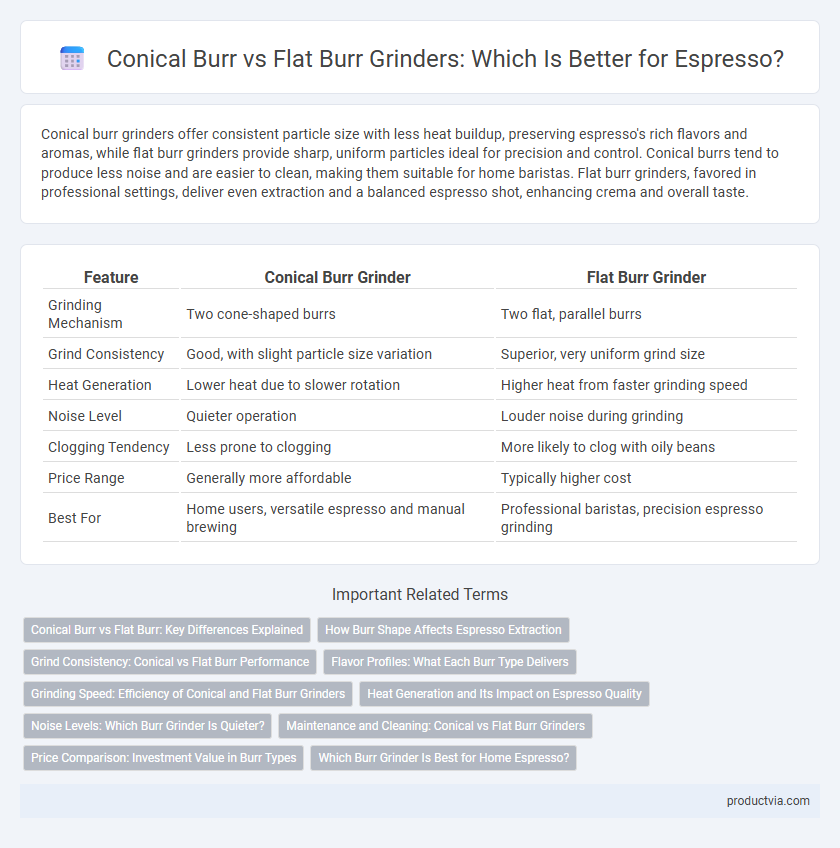Conical burr grinders offer consistent particle size with less heat buildup, preserving espresso's rich flavors and aromas, while flat burr grinders provide sharp, uniform particles ideal for precision and control. Conical burrs tend to produce less noise and are easier to clean, making them suitable for home baristas. Flat burr grinders, favored in professional settings, deliver even extraction and a balanced espresso shot, enhancing crema and overall taste.
Table of Comparison
| Feature | Conical Burr Grinder | Flat Burr Grinder |
|---|---|---|
| Grinding Mechanism | Two cone-shaped burrs | Two flat, parallel burrs |
| Grind Consistency | Good, with slight particle size variation | Superior, very uniform grind size |
| Heat Generation | Lower heat due to slower rotation | Higher heat from faster grinding speed |
| Noise Level | Quieter operation | Louder noise during grinding |
| Clogging Tendency | Less prone to clogging | More likely to clog with oily beans |
| Price Range | Generally more affordable | Typically higher cost |
| Best For | Home users, versatile espresso and manual brewing | Professional baristas, precision espresso grinding |
Conical Burr vs Flat Burr: Key Differences Explained
Conical burr grinders feature cone-shaped burrs that offer slower grinding speeds and produce a more consistent grind size, enhancing espresso flavor extraction. Flat burr grinders use two parallel flat discs that crush beans at higher speeds, resulting in more heat generation but providing precise particle size distribution. Choosing between conical and flat burrs depends on desired grind consistency, heat impact, and flavor profile preferences in espresso brewing.
How Burr Shape Affects Espresso Extraction
Conical burr grinders produce a more uniform particle size distribution, which enhances espresso extraction by promoting even water flow and consistent flavor extraction. Flat burr grinders generate a narrower particle size range, resulting in a finer grind that can intensify crema and highlight espresso's acidity and brightness. Burr shape directly influences grind consistency, extraction rate, and ultimately the balance of taste, body, and aroma in the finished espresso.
Grind Consistency: Conical vs Flat Burr Performance
Conical burr grinders typically provide superior grind consistency by producing uniform particle sizes, essential for balanced espresso extraction and rich flavor profiles. Flat burrs, while offering precise control over grind size, can sometimes generate more fines, which may lead to over-extraction and bitterness. Choosing between conical and flat burrs depends on the desired espresso outcome; conical burrs excel in consistent grind distribution, whereas flat burrs offer sharper particle size differentiation for clarity in taste.
Flavor Profiles: What Each Burr Type Delivers
Conical burr grinders produce a more consistent particle size distribution, enhancing sweetness and clarity in espresso by preserving delicate flavor notes. Flat burr grinders generate uniform grind sizes that emphasize brightness and acidity, delivering a cleaner and more vibrant cup. The choice between conical and flat burrs directly influences the espresso's complexity and balance, shaping distinct flavor profiles favored by different coffee enthusiasts.
Grinding Speed: Efficiency of Conical and Flat Burr Grinders
Conical burr grinders typically operate at slower grinding speeds, which reduces heat buildup and preserves coffee flavor during espresso preparation. Flat burr grinders often grind faster, offering efficiency for high-volume settings but may generate more heat, potentially affecting espresso quality. Choosing between conical and flat burrs depends on balancing grinding speed with desired flavor preservation and operational demands.
Heat Generation and Its Impact on Espresso Quality
Conical burr grinders produce less heat during grinding due to their slower rotational speed, preserving the coffee's aromatic compounds and oils, which enhances espresso flavor and crema. Flat burr grinders generate more heat as a result of higher friction between burr surfaces, risking the degradation of delicate coffee oils and causing a slightly bitter or burnt taste. Managing heat generation is crucial for maintaining the consistency and quality of espresso extraction, with conical burrs generally preferred for minimizing thermal impact.
Noise Levels: Which Burr Grinder Is Quieter?
Conical burr grinders produce less noise compared to flat burr grinders due to their slower rotation speed and more efficient grinding mechanism. The quieter operation of conical burrs enhances the espresso preparation experience, minimizing disturbance in home or cafe environments. Flat burr grinders, while offering consistency in grind size, generally operate louder due to higher RPMs and the design of their burrs.
Maintenance and Cleaning: Conical vs Flat Burr Grinders
Conical burr grinders feature fewer parts and larger clearances, making them easier to disassemble and clean compared to flat burr grinders, which often require more precise alignment and more frequent deep cleaning to maintain performance. Residue buildup is less common in conical burrs due to their shape and slower rotation speed, reducing the frequency of maintenance needed for espresso consistency. Flat burr grinders, while offering a uniform grind, demand diligent upkeep to prevent clogged burrs that can affect espresso extraction and flavor quality.
Price Comparison: Investment Value in Burr Types
Conical burr grinders typically offer a lower upfront cost compared to flat burr grinders, making them an attractive option for home espresso enthusiasts seeking value. Flat burr grinders, while often more expensive, provide superior consistency and grind uniformity, which can justify the higher price through enhanced espresso quality. Investing in flat burrs may yield better long-term satisfaction for precise extraction despite the initial cost difference.
Which Burr Grinder Is Best for Home Espresso?
Conical burr grinders are ideal for home espresso due to their slower grinding speed, which reduces heat buildup and preserves coffee flavor, while their angled burrs provide consistent particle size essential for espresso extraction. Flat burr grinders offer uniform grind size and produce less coffee powder, contributing to a cleaner taste, but they typically generate more heat and noise, which may affect delicate espresso flavors in a home setting. For home espresso enthusiasts prioritizing flavor clarity and ease of use, conical burr grinders often provide the best balance between grind consistency, heat management, and maintenance requirements.
Conical burr vs flat burr for espresso Infographic

 productvia.com
productvia.com